The Complete Guide to Brow Lift” recovery and results provides expert insights into what patients can expect during the healing process and long-term outcomes. The brow lift has emerged as one of the fastest-growing cosmetic procedures globally, with 524,386 procedures performed worldwide in 2024 representing a remarkable 27.5% increase from the previous year. This surge reflects a broader renaissance in facial rejuvenation procedures, positioning the brow lift as a cornerstone treatment for patients seeking natural, long-lasting results through medical tourism destinations worldwide. Whether you’re considering domestic or international treatment, Whether you’re considering domestic or international treatment, “The Complete Guide to Brow Lift” surgery offers comprehensive information about costs, techniques, and destination selection. BOOK NOW – Your Medical Journey Deserves Perfect Communication!

For medical tourism patients, the brow lift offers compelling advantages: significant cost savings compared to domestic markets, access to world-class surgeons and facilities, and the opportunity to combine recovery with a therapeutic getaway. With the global medical tourism market valued at USD 107.5 billion in 2024 and projected to reach USD 890.4 billion by 2035, cosmetic procedures like brow lifts are driving unprecedented growth in this sector.
Before and after comparison of a brow lift surgery showing elevated brows and a smoother forehead area
Understanding Brow Lift Surgery: Anatomy and Techniques
The Science Behind Brow Aging
Brow ptosis, or drooping eyebrows, occurs due to gravitational descent of soft tissues, weakening of the frontalis muscle, and hyperactivity of brow depressor muscles. The key anatomical structures involved include the corrugator supercilii, procerus, and depressor supercilii muscles. These muscles, when overactive, create the frown lines between the eyebrows and contribute to the aged appearance of the upper face.
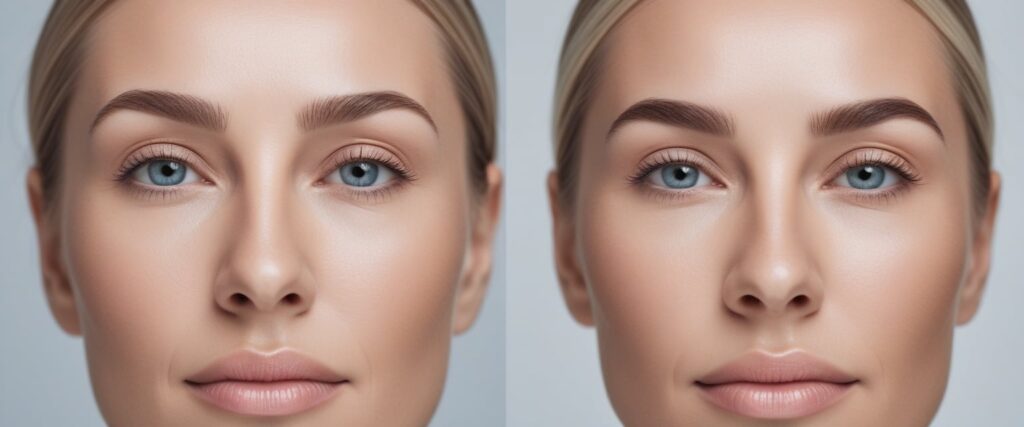
Posterior view of forehead and scalp muscles including the procerus and corrugator supercilii involved in brow movement anatomy
The aging process affects different regions of the brow at varying rates. Research demonstrates that the lateral brow typically descends more dramatically than the medial portion, creating asymmetry and a tired appearance. Understanding this anatomical variation is crucial for selecting the appropriate surgical technique and achieving optimal results.
Modern Brow Lift Techniques: The Complete Guide to Brow Lift
Contemporary brow lift surgery offers multiple approaches, each with distinct advantages for different patient populations and aesthetic goals.
Diagram illustrating surgical incision locations for different brow lift techniques including coronal, endoscopic, pretrichial, and lateral temporal approaches
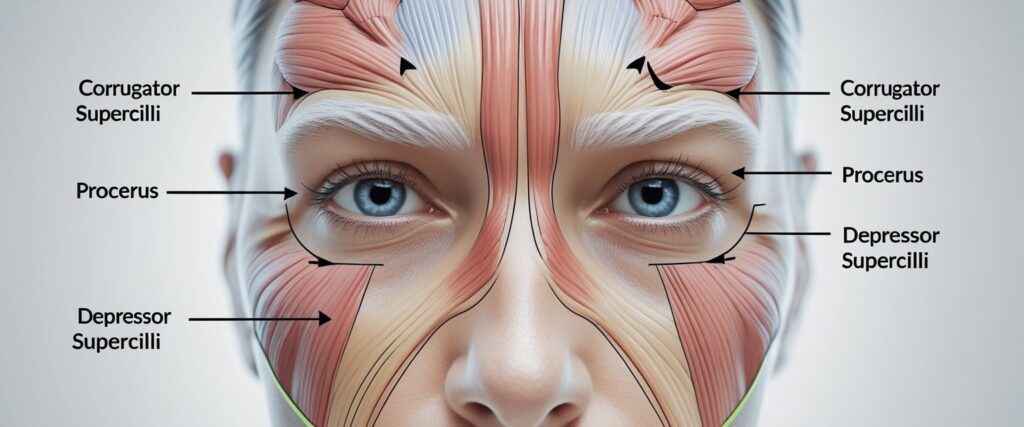
Endoscopic Brow Lift has become the gold standard for most patients, offering superior outcomes with minimal invasiveness. This technique utilizes small 3-5 incisions behind the hairline and employs an endoscope for precise visualization of underlying structures. Studies show endoscopic approaches achieve average elevation of 3.25mm medially, 3.86mm centrally, and 4.35mm laterally, with complication rates significantly lower than traditional methods.
Gliding Brow Lift (GBL) represents the newest innovation in brow elevation, gaining popularity due to its effectiveness and low complication rates. Systematic reviews of 181 patients demonstrate that GBL provides stable, natural-looking results with minimal scarring and faster recovery times compared to conventional approaches.
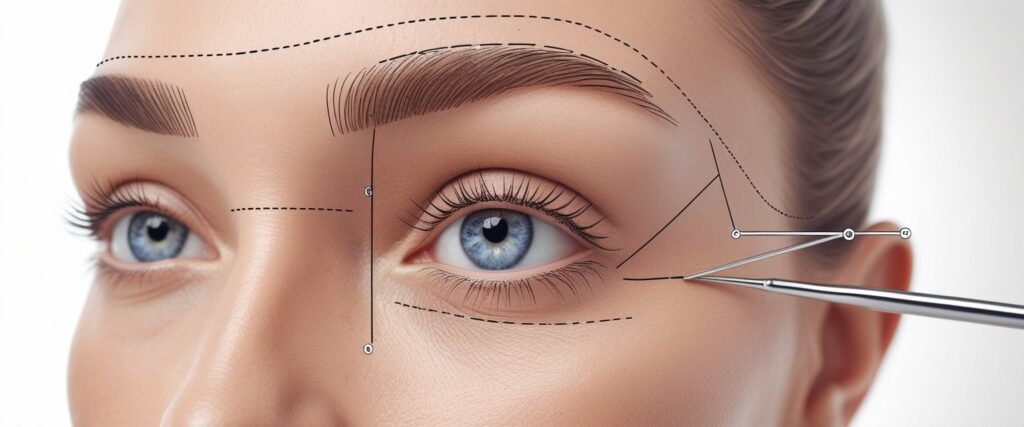
Direct Brow Lift remains the preferred technique for specific populations, particularly men with receding hairlines and patients with facial nerve palsy. This approach offers the most predictable lift per millimeter of tissue removed but carries higher risk of visible scarring.
Temporal Brow Lift addresses lateral brow ptosis specifically, making it ideal for patients who require subtle elevation of the outer brow area without affecting the central forehead. This technique has seen increased adoption as surgeons move toward more targeted, minimally invasive approaches.
Surgical Innovation: Advanced Techniques
The field continues to evolve with cutting-edge approaches like Helium Plasma Radiofrequency Brow Lift, which combines traditional lifting with advanced energy-based tissue tightening. Early studies of 26 patients show promising results when combined with other facial procedures, though long-term data remains limited.
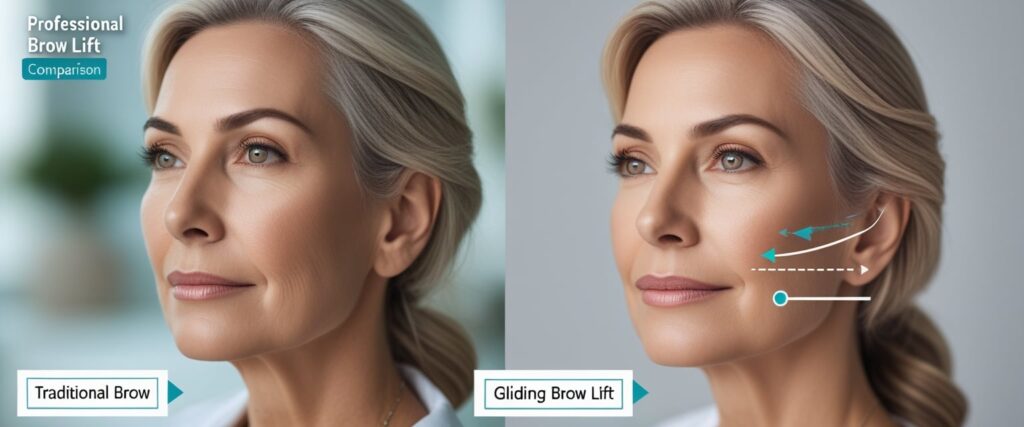
Vertical Internal Brow Suspension (VIBS) represents another breakthrough, specifically designed to prevent lateral brow relapse, historically one of the most challenging complications in endoscopic procedures. Studies of 118 patients demonstrate significant brow height increases across all measurement levels with minimal complications.
Medical Tourism Excellence: Global Destinations for Brow Lift Surgery
Leading Medical Tourism Hubs
Turkey has emerged as the premier destination for cosmetic surgery tourism, with 1,110,306 total aesthetic procedures performed in 2024. Turkish clinics combine advanced surgical techniques with competitive pricing, often offering brow lift procedures at 60-70% less than North American and European costs.
India continues to expand its medical tourism footprint with 1,288,840 aesthetic procedures in 2024, representing a 25.3% increase. The country offers exceptional value for brow lift surgery, with procedures ranging from INR 60,000 to INR 1,50,000 (approximately $720-$1,800). Leading hospitals like Richardsons Hospital provide state-of-the-art facilities with internationally trained surgeons.

South Korea maintains its reputation for innovative techniques and superior outcomes, particularly for facial procedures. The country’s focus on precision and natural-looking results has made it a top destination for American patients seeking eyelid and brow procedures.
Mexico and the Dominican Republic serve substantial numbers of North American patients, offering geographic convenience and established medical tourism infrastructure. These destinations typically provide 40-60% cost savings compared to US procedures while maintaining high safety standards.
Quality and Safety Considerations
Medical tourism success depends critically on proper facility selection and surgeon credentials. Research indicates that aesthetic medical tourism patients have a 4.6 times higher risk of complications compared to domestic procedures, making due diligence essential.
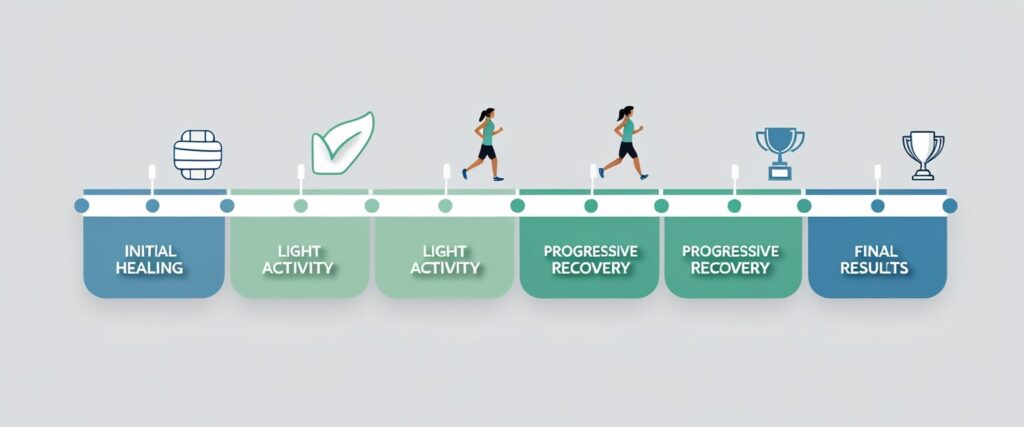
Key safety factors include:
- Board certification in plastic surgery or equivalent credentials
- Hospital accreditation by recognized international bodies
- English-speaking staff and comprehensive patient support
- Transparent pricing with no hidden fees
- Follow-up care protocols for post-operative monitoring
Medical professionals consulting a patient in a cosmetic surgery clinic during a pre-operative assessment
Clinical Outcomes and Evidence-Based Results
Efficacy and Longevity
Recent meta-analyses provide compelling evidence for brow lift effectiveness and durability. Long-term studies demonstrate that properly executed endoscopic brow lifts maintain significant elevation for over 24 months with patient satisfaction rates exceeding 90%.
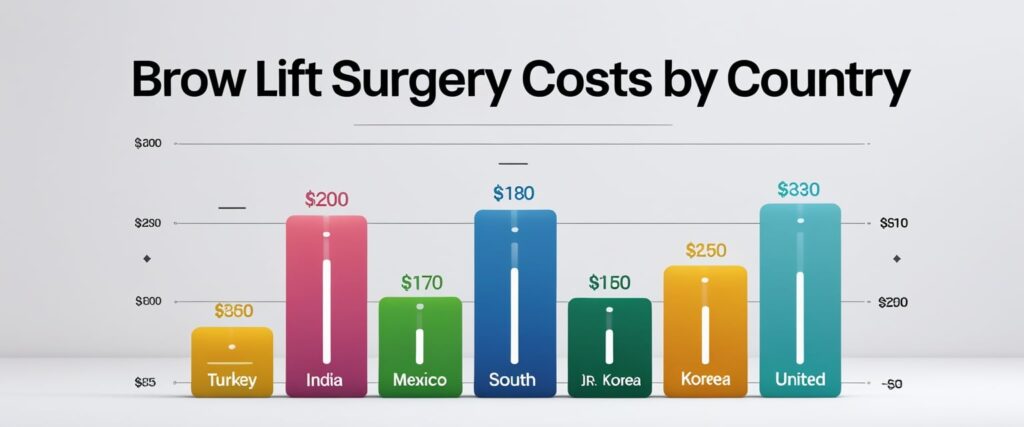
Patient satisfaction surveys reveal that 63% of patients would undergo the procedure again, with most reporting improved self-confidence and perceived age reduction. The procedure consistently achieves natural-looking results without the “windswept” appearance associated with older techniques.
Complication Profiles and Risk Management
Comprehensive systematic reviews of 7,273 endoscopic brow lift patients reveal reassuring safety profiles:
- Alopecia (hair loss): 2.8% – typically temporary and resolves within 6 months
- Numbness: 2.0% – usually transient, with full sensation returning in most cases
- Revision rate: 1.2% – significantly lower than traditional open techniques
- Asymmetry: 0.7% – often correctible with minor adjustments
- Serious complications: <0.5% – including nerve injury, infection, and hematoma
Temporal lift complications include unfavorable scarring in 85% of cases and permanent scalp numbness in 31%. These higher rates explain the trend toward endoscopic and gliding techniques for most patients.
Clean infographic comparing brow lift costs across countries (Turkey, India, Mexico, South Korea, US) using bars or currency icons.
| Statistic | Value | Source |
|---|---|---|
| ISAPS Global Brow Lift Procedures 2024 | 524,386 procedures | ISAPS Global Survey 2024 |
| ISAPS Brow Lift Growth 2023-2024 | +27.5% increase | ISAPS Global Survey 2024 |
| BAAPS UK Brow Lift Growth 2024 | +25% increase | BAAPS Annual Audit 2024 |
| Average Brow Elevation (mm) – Medial | 3.25 mm | Oxford Academic Meta-Analysis 2024 |
| Average Brow Elevation (mm) – Central | 3.86 mm | Oxford Academic Meta-Analysis 2024 |
| Average Brow Elevation (mm) – Lateral | 4.35 mm | Oxford Academic Meta-Analysis 2024 |
| Endoscopic Brow Lift Alopecia Rate | 2.8% | PMC Systematic Review 2018 |
| Endoscopic Brow Lift Numbness Rate | 2.0% | PMC Systematic Review 2018 |
| Endoscopic Brow Lift Revision Rate | 1.2% | PMC Systematic Review 2018 |
| Medical Tourism Market Value 2024 | USD 107.5 billion | Future Market Insights 2025 |
| Medical Tourism Market Projection 2035 | USD 890.4 billion | Future Market Insights 2025 |
| Aesthetic Surgery Tourism Complication Rate (AMT) | 8.7% (75 of 865 patients) | Aerospace Medicine Study 2024 |
| US Citizens Seeking Medical Care Abroad | 15 million annually | PMC Medical Tourism Study 2024 |
| Facial Feminization Average Brow Lift | 4.6 mm elevation | Liebertpub FFS Study 2022 |
| Brow Lift Patient Satisfaction Rate | 63% would repeat procedure | German Survey Archives 2023 |
Recovery Timeline and Expectations
Phase-by-Phase Recovery Guide
Days 1-7: Initial Healing
- Moderate swelling and bruising peak around days 2-4
- Prescribed pain medication manages discomfort effectively
- Head elevation and cold compresses reduce swelling
- No strenuous activity to protect healing tissues
Weeks 1-2: Return to Light Activities
- Most patients return to office work within 10-14 days
- Swelling reduces by approximately 70%
- Sutures or clips removed if used
- Light makeup can conceal residual bruising
Weeks 2-6: Progressive Recovery
- Full activity clearance typically at 6 weeks
- Numbness and tightness gradually resolve
- Exercise restrictions lifted progressively
- Sun protection remains crucial
Months 3-6: Final Results
- Complete healing achieved by 6 months
- Scars fade to barely perceptible lines
- Final brow position stabilizes
- Patient satisfaction assessment most accurate at this stage
Managing Patient Expectations
Realistic expectation setting remains crucial for patient satisfaction. The procedure achieves natural rejuvenation rather than dramatic transformation, with most patients appearing 5-10 years younger following complete healing.
Common patient concerns include temporary forehead numbness, which affects up to 47% of patients but typically resolves within 6 months. Hair thinning around incision sites occurs in 5.1% of cases but is generally minimal and temporary.
Cost Analysis and Value Proposition
International Price Comparisons
Medical tourism offers substantial savings for brow lift procedures:
| Destination | Average Cost (USD) | Savings vs. US | Additional Benefits |
|---|---|---|---|
| Turkey | $2,500-4,000 | 60-75% | Comprehensive packages, luxury recovery |
| India | $720-1,800 | 80-85% | Extended stay options, cultural experience |
| Mexico | $3,000-5,000 | 40-60% | Geographic convenience, established networks |
| South Korea | $4,000-7,000 | 30-50% | Advanced techniques, precision outcomes |
| Thailand | $2,800-4,500 | 55-70% | Medical spas, holistic recovery |

US baseline costs range from $8,000-15,000 depending on surgeon experience and geographic location. These figures exclude facility fees, anesthesia, and post-operative care, which can add $3,000-5,000 to total expenses.
Hidden Cost Considerations
The Complete Guide to Brow Lift” surgery offers comprehensive information about costs, techniques, and destination selection. Medical tourism patients must factor additional expenses:
- International airfare: $500-2,000
- Accommodation: $100-300 per night
- Extended stay requirements: 7-14 days minimum
- Companion travel costs if desired
- Post-operative garments and medications
Despite these additions, total costs typically remain 40-60% below domestic pricing while offering superior amenities and personalized care.
Technological Advancement and Future Directions
Minimally Invasive Innovations
The field continues evolving toward less invasive techniques with equivalent outcomes. Thread lifts and advanced energy-based devices offer temporary alternatives, though longevity remains limited compared to surgical approaches.

Combination procedures are increasingly popular, with 73% of patients undergoing concurrent facelifts and 77% receiving facial fat grafting. This trend reflects patient desire for comprehensive facial rejuvenation through single recovery periods.
Artificial Intelligence and Surgical Planning
Advanced imaging and AI-assisted surgical planning are revolutionizing patient consultations and outcome prediction. These technologies enable surgeons to provide more accurate previews of expected results and optimize surgical approaches for individual facial anatomy.

3D simulation technology helps patients visualize potential outcomes while managing expectations appropriately. This technology is particularly valuable for medical tourism patients who may have limited pre-operative consultation time.
Choosing the Right Surgeon and Facility
Credential Verification
Board certification verification remains the most critical factor in surgeon selection. International patients should confirm:
- Primary specialty training in plastic surgery or equivalent
- Hospital privileges at accredited facilities
- Professional society memberships (ISAPS, national plastic surgery associations)
- Continuing education compliance and specialty certifications

Red Flags to Avoid
- Unrealistic promises or guaranteed outcomes
- Pressure tactics or limited-time offers
- Lack of proper credentials or evasive responses about training
- No hospital affiliations or operating only in office settings
- Poor communication or language barriers
- Unclear pricing or demands for full payment upfront
The Medical Tourism Process: Step-by-Step Success Guide
Phase 1: Research and Selection (2-3 months before surgery)
- Research destinations and narrow to 2-3 options
- Verify surgeon credentials through official databases
- Request detailed treatment protocols and pricing
- Read verified patient reviews from multiple sources
- Conduct video consultations with top candidates
Phase 2: Pre-Surgical Preparation (4-6 weeks before)
- Complete medical clearance with home physician
- Arrange travel documents and medical visas if required
- Purchase travel insurance with medical coverage
- Plan accommodations near surgical facility
- Arrange companion travel if desired
Phase 3: Treatment Journey (1-2 weeks on-site)
- Arrive 2-3 days before surgery for final consultations
- Complete pre-operative testing and medical evaluation
- Undergo surgery with planned recovery monitoring
- Follow post-operative protocols strictly
- Attend follow-up appointments before departure
Phase 4: Post-Treatment Care (ongoing)
- Maintain communication with surgical team
- Follow home care instructions meticulously
- Attend local follow-up if arranged
- Document recovery progress with photos
- Plan return visits if recommended

Conclusion
Brow lift surgery through medical tourism represents an exceptional opportunity for patients seeking natural facial rejuvenation at accessible costs. With global procedure volumes increasing 27.5% annually and complication rates below 3% for endoscopic techniques, the procedure offers compelling risk-benefit profiles for appropriate candidates. The Complete Guide to Brow Lift” procedures includes detailed analysis of safety profiles, with endoscopic techniques showing complication rates below 3% in systematic reviews.
Success depends critically on thorough research, careful surgeon and facility selection, and realistic expectation management. Patients who invest time in proper preparation and choose accredited providers in established medical tourism destinations can expect outstanding outcomes with substantial cost savings.
The combination of advanced surgical techniques, competitive international pricing, and comprehensive care packages positions brow lift medical tourism as a transformative option for facial rejuvenation. As the industry continues evolving with improved safety protocols and technological innovations, patients can approach these procedures with confidence in both outcomes and experiences. Medical tourism patients will find “The Complete Guide to Brow Lift” surgery invaluable for understanding international pricing, surgeon credentials, and facility selection criteria.
Frequently Asked Questions About Brow Lifts
1. How much does a brow lift cost in 2024?
Answer: The cost of a brow lift varies significantly based on location, surgeon experience, and technique used. In the United States, patients can expect to pay $5,000-$15,000 for the procedure. According to patient reviews, the average cost is approximately $8,681, though prices can range from $3,000 to $19,000.
Medical tourism offers substantial savings:
- India: $720-$3,000 (INR 60,000-2,50,000)
- Turkey: $1,500-$4,000
- Thailand: $2,800-$4,500
- Mexico: $3,000-$5,000
It’s important to note that the ASPS quoted fee of $5,460 represents only the surgeon’s fee and doesn’t include anesthesia, facility costs, or post-operative care. Medical tourism patients should factor in additional expenses like travel, accommodation, and extended stay requirements while still achieving 40-60% savings compared to domestic pricing.
2. How long is the recovery time after a brow lift?
Answer: Brow lift recovery follows a predictable timeline, though individual healing varies. Here’s what patients can expect:
Week 1: Swelling and bruising peak around days 2-4, then gradually subside. Head elevation and cold compresses help manage symptoms.
Weeks 1-2: Most patients return to office work within 10-14 days. Swelling reduces by approximately 70%, and makeup can conceal residual bruising.
Weeks 2-6: Progressive improvement with full activity clearance typically at 6 weeks. Light exercise may be permitted after 3-4 weeks with surgeon approval.
Months 3-6: Complete healing achieved by 6 months. Final results become apparent as all swelling resolves and scars fade to barely perceptible lines.
Most patients feel “almost fully recovered” by one month post-surgery, though the complete healing process takes approximately six months for final results.
3. What’s the difference between a brow lift and Botox?
Answer: While both treatments address forehead aging, they work through entirely different mechanisms and offer distinct advantages:
Longevity:
- Brow lift: Results last 10-15 years or more
- Botox: Effects last 3-4 months requiring ongoing maintenance
Mechanism:
- Brow lift: Surgical repositioning of tissues and muscles for structural correction
- Botox: Temporary muscle relaxation to smooth dynamic wrinkles
Best candidates:
- Brow lift: Significant brow sagging, deep wrinkles, desire for permanent solution
- Botox: Mild drooping, dynamic wrinkles, preference for non-surgical approach
Customization: A brow lift offers superior precision and customization, allowing surgeons to reshape the entire brow area and address asymmetry. Botox provides immediate results with no downtime but cannot correct structural sagging that occurs with aging.
Many patients start with Botox as a conservative approach before considering surgical intervention. Some may benefit from combination treatments where surgery addresses structural issues and Botox maintains results by preventing new wrinkle formation.
4. Are there different types of brow lift procedures?
Answer: Yes, modern brow lift surgery offers several distinct approaches, each suited to specific patient needs and anatomical considerations:
Endoscopic Brow Lift: The current gold standard using 3-5 small incisions hidden in the hairline. Offers minimal scarring, faster recovery, and precise results with complication rates below 3%.
Coronal (Traditional) Brow Lift: Uses one long incision from ear to ear across the hairline. Provides maximum lifting power but involves more extensive scarring and longer recovery.
Temporal Brow Lift: Focuses specifically on lateral brow elevation through temple incisions. Ideal for patients needing subtle outer brow lifting without affecting the central forehead.
Direct Brow Lift: Incisions made directly above the eyebrows. Particularly suitable for men with receding hairlines and patients with facial nerve palsy, though scarring is more visible.
Pretrichial (Hairline) Brow Lift: Incision placed at the hairline, beneficial for patients with high foreheads who want to avoid further hairline elevation.
Your surgeon will evaluate your facial anatomy, aging patterns, and aesthetic goals to recommend the most appropriate technique. Endoscopic approaches are increasingly popular due to their minimal invasiveness and natural-looking results, while traditional methods may be preferred for patients requiring more dramatic correction.
